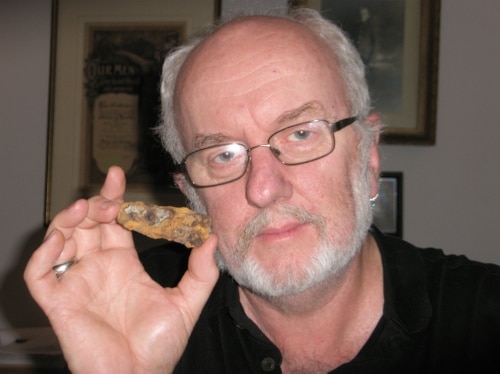This article was translated by John R. Bopp
About a month ago, we brought you the story of an incredible discovery: a Basque ax that had been found buried in a Huron People site dating from 1500. In that report, we mentioned that this discovery by Ron Williamson and his colleagues was so important that they were going to debut a documentary on July 6 titled “The Curse of the Axe” at the Royal Ontario Museum, and then nationwide on July 9.
(The documentary is now available online; we’ll leave you a list of links below). In the meantime, we’d like to leave you with some information about the broadcasting of this documentary being shown by Global News. In addition to the information from the TV, we’ll leave you with a radio program from the CBC and a news item that appeared on the website Indian Country, going in-depth on this extraordinary find.

By the way, we need to point out that the ax found is not Spanish, but Basque. This isn’t just a political point (which it is), but also historical, since Spain as a country didn’t exist until the start of the 19th Century, and that ax, as you can tell, is from the 15th. This was approximately when the Moors still ruled Granada, the Kingdom of Navarre had not yet been invaded and subjugated by the Castilians, and the Basques still had customs in Orduña. Yes, those men who reached the coasts of North America, chasing after whales and fish, were Basques, who spoke in Basque, and who were ruled by the laws their own parliaments made.
This point is especially directed at the writers of the report that appeared in Indian Country. Calling those Basque Spaniards is as historically accurate as calling the Hurons whose settlement the ax was found in, or those who would be forced to obey the colonizers’ laws a century later, English.
CBC Radio – 9/7/2012 – Canada
The Curse of the Axe
Archaeologists were stunned and thrilled by the size and complexity of a Huron village excavated in Whitchurch-Stouffville north of Toronto. But they were puzzled by a little piece of Europe the Hurons carefully preserved… a piece that arrived long before the Hurons made first contact with the Europeans. But how? That mystery was solved after months of forensic sleuthing.
(Follow) (Automatic translation)
————————-
Indian Country Today Media Network – 9/7/2012 – Canada
How Did a Spanish Axe Wind Up in Toronto 100 Years Before Europeans?
Tonight, July 9th, Canadian cable channel History Television will present Curse of The Axe, a documentary about the archeological discovery of Mantle, the largest Huron First Nations village discovered to date. The site, located in present-day Stouffville, near Toronto, once contained 90 long houses and 3 rows of defensive walls which required chopping down 60,000 trees for their construction. Beyond those walls the Huron cultivated over 2,000 acres of corn that stretched 2 kilometers (slightly less than 1¼ miles) in every direction from the village. The land mass the village and the corn fields covered would have been as large as a contemporary city.
(Follow) (Automatic translation)
————————–
The Documentary
It’s quite exciting to see (starting at 69:54) the trip the Canadian archaeologists make to the Basque Country, their visit to a blacksmith’s shop in Zerain, Gipuzkoa, which is now the Azpeitia Visitors’ Center, and the discovery of iron pieces that had been made in the Basque Country, specifically, an ax, with the same mark as the one in Canada.
Last Updated on Dec 20, 2020 by About Basque Country




























